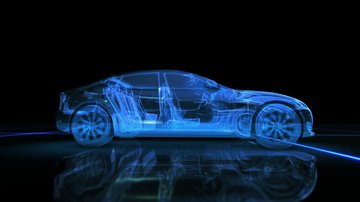Electric Vehicle Lubricant and Fluid Testing
- Copper compatibility. Fluids in contact with electric motors should not corrode copper windings.
- Load-carrying ability. Electric motors produce very high torque, which stresses gears in new ways.
- Aeration/foaming. The trend is toward higher-speed electric motors (even higher than 10,000-15,000 rpm), which could lead to air entrainment in the fluid.
- Electrical conductivity. There is a limit to how conductive the fluid can be without causing problems with electrical components. On the other hand, if the conductivity is too low, static electricity build-up could be a concern.
- Thermal conductivity. Fluids with higher thermal conductivity would keep the motor and drive system running cool, but oils are intrinsically poor heat conductors.
- Viscosity and friction. Any reduction in friction can extend the battery life and range of an EV.1
Different EV drivetrain formulations may have
inherently varying corrosion rates producing conducting layer deposits in both
solution and vapor phases. Conductive deposits form from the chemical reaction
of the lubricating fluid and the copper at elevated temperatures under low
voltage electrified conditions both in the fluid and at the vapor state. Of concern are corrosion, deposits, and
conductive deposits.
The evolution of fully electric and hybrid transportation continues to evolve and the same is true with the test methods and equipment for those critical areas of interest.
The Wire Corrosion Test (WCT), originally developed by Lubrizol, is a new test offered by Savant Labs. In agreement with The Lubrizol Corporation, Savant Labs are the sole source for this testing service in North America.
The WCT identifies corrosion and depletion of copper on a test wire in both fluid and vapor state. The WCT concept is to evaluate chemical reactions forming corrosion at temperatures compatible to actual performance. Oxidation and the ensuing chemical reaction on the copper wire can cause depletion of the motor winding in the EV powertrain. A sensitive wire resistance measurement method is utilized to provide a real-time assessment of copper loss due to corrosion. This test provides formulators a direct, quantitative measurement of this important attribute as opposed to current methods that attempt to infer this from visual inspection or copper concentrations in solution.
In addition, Conductive Deposit Test (CDT), equipment developed by Tannas Co., is now also available.
CDT is a unique test in that it identifies the formation of conductive bridging between tightly spaced conductors under an applied voltage. CDT emulates conditions where you have multiple conductors in close proximity in contact with lubricating fluids under potentially restricted flow conditions or condensed vapors. Motor windings are a good example.
The CDT and WCT tests are available at Savant Labs. Please contact us for a quote.
SAE J3200 Electric Drivetrain Fluids (EDF)
While there are currently no finalized standards for electric drivetrain fluids, the SAE instruction document (SAE J3200) published in October of 2022 focuses on thermal and electrical conductivity, oxidation, and copper corrosion. This report will assist those concerned with lubricants used in drivetrain components powered by electrified vehicles and will become a classification that specification setting organizations can utilize for their recommended practices.
Below is a list of tests Savant can perform that may be useful for hybrid and electric vehicle applications.
ASTM International Method
- ASTM D92 Flash and Fire Points by Cleveland Open Cup
- ASTM D97 Pour Point
- ASTM D130 Copper Strip Corrosion
- ASTM D217 Cone Penetration
- ASTM D445 Viscosity, Kinematic at 100°C
- ASTM D664 Acid Number
- ASTM D665 Rust Prevention 4 Hours (Method A or B)
- ASTM D665 Rust Prevention 24 Hours (Method A or B)
- ASTM D877 Dielectric Breakdown Voltage
- ASTM D892 Foaming Characteristics of Lubricating Oils
- ASTM D924 Dissipation/Power Factor
- ASTM D1177 Freeze Point
- ASTM D1331 Surface Tension
- ASTM D2270 Viscosity Index (Includes D445 at 40°C and 100°C)
- ASTM D2596 Four-Ball Extreme Pressure
- ASTM D2624 Electrical Conductivity of Aviation and Distillate Fuels
- ASTM D2717 Thermal Conductivity - Single Temperature
- ASTM D2983 Brookfield Viscosity, +20°C to -60°C (Per Temperature)
- ASTM D3336 High-Temperature Bearing Performance Up to 600 Hours
- ASTM D3427 Air Release, Gas Bubble Separation
- ASTM D4048 Copper Strip Corrosion, Grease
- ASTM D4052 Specific Gravity (Includes API Gravity)
- ASTM D4683 High-Temperature High Shear / TBS Viscosity at 150°C
- ASTM D4684 TP-1 MRV Viscosity
- ASTM D4951 Elemental Analysis by Inductively Coupled Plasma, Wear Metals
- ASTM D5182 FZG Gear Test - Up to 12 and 14 Stages
- ASTM D5185 Elemental Analysis by Inductively Coupled Plasma
- ASTM D5293 Cold Cranking Simulator
- ASTM D6082 Foaming, Sequence IV (Specify Option A if Required)
- ASTM D6138 Corrosion-Preventive, Dynamic Wet Conditions (Emcor Test)
- ASTM D6304 Water by Karl Fischer
- ASTM D6417 Simulated Distillation by Gas Chromatography
- ASTM D6443 Chlorine by XRF
- ASTM E1269 Specific Heat Capacity by Differential Scanning Calorimetry
- CEC L-45-99 mod. & D445 KRL Shear 20 Hours + 1 Temperature pre & post Shear KV
- CEC L-48 Oxidation Stability of Lubricating Oils by Artificial Aging
- DIN 51805 Flow Pressure, Kesternich Method
- SAVLAB EV-CDT Conductive Deposit Test
- SAVLAB EV-WCT Wire Corrosion Test
Grease for EV Gears and Bearings
The e-motor in the delivery of power within the drivetrain provides full torque from the start and maintains it over a wide range of speeds. High torque and low-speed combinations place additional stress on drivetrain components, like gears and bearings. ASTM International’s committee on petroleum products, liquid fuels, and lubricants (D02) already has many lubricant-related standards in place that can be adapted to the electric vehicle market and spur its future growth.
ASTM International Method
ASTM D217 Cone Penetration
ASTM D1264 Water Washout (Single Temperature)
ASTM D1478 Low-Temperature Torque - Grease
ASTM D1742 Oil Separation, Storage of Greases
ASTM D1831 Roll Stability of Grease
ASTM D2265 Dropping Point
ASTM D2266 Four-Ball Wear Grease
ASTM D2596 Four-Ball Extreme Pressure Up to 400 kg.
ASTM D2596 Four-Ball Extreme Pressure Above 400 kg.
ASTM D3336 High-Temperature Bearing Performance
ASTM D4170 Fretting Wear, Grease
ASTM D4289 Elastomer Compatibility NBR L and CR Grease
ASTM D4289 Elastomer Compatibility NBR L or CR Grease
ASTM D4693 Low-Temperature Torque, Grease
ASTM D5706 Extreme Pressure, High-Frequency, Linear Oscillation, SRV
ASTM D6138 Corrosion-Preventive, Dynamic Wet Conditions (Emcor Test)
ASTM D6184 Oil Separation from Lubricating Grease
ASTM D7594 Fretting Wear, High Hertzian Contact, High-Frequency, Linear-Oscillation, SRV
As leaders in lubrication testing and research, Savant Labs can help you prepare for the future as you develop fluids that meet the expanding EV industry requirements. Contact us.
1 Society of Tribologists and Lubrication Engineers - STLE, Cover Story, August 2021

